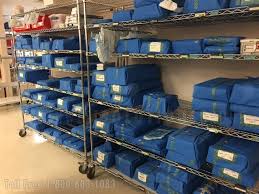In healthcare, pharmaceuticals, and laboratory settings, sterilization is essential to ensure patient safety and maintain high standards of hygiene. However, one critical question remains: How long can sterilized instruments be stored before they need to be reprocessed?
Sterilization is an important process for your medical facility, and maintaining your sterilized instruments’ integrity in storage can significantly impact your operations.
At INSTECH Pharma, we understand the importance of proper sterilization protocols, so let’s explore the factors that influence storage duration and how to maximize the shelf life of sterilized instruments and medical facilities may use varying approaches.
INSTECH Pharma also Provide Bung Processor Cum Sterilizer and HPHV Steam Sterilizer.
Factors Affecting the Storage of Sterilized Instruments
The longevity of sterilized instruments depends on multiple factors, including:
1. Type of Sterilization Method
Different sterilization techniques impact how long instruments remain sterile:
- Steam Sterilization (Autoclaving): If stored properly, items can remain sterile for 6–12 months.
- Ethylene Oxide (EO) Sterilization: Can maintain sterility for up to 5 years, provided they remain sealed.
- Hydrogen Peroxide Plasma Sterilization: Typically offers sterility for 1–2 years in sealed packaging.
2. Packaging Integrity
The sterility of instruments relies heavily on the condition of their packaging. Common sterilization wraps include:
- Peel pouches or sterilization wraps: Must remain intact, as any tear or puncture compromises sterility.
- Rigid containers: Provide better protection and extend storage time compared to paper or plastic wraps.
3. Storage Conditions
Proper storage environments significantly affect sterility. Key factors include:
- Temperature & Humidity Control: Store in a cool, dry area to prevent microbial contamination.
- Limited Handling: Frequent movement increases the risk of contamination.
- Dust-Free, Clean Shelves: Instruments should be stored away from direct sunlight, excessive moisture, and dust.
Recommended Storage Guidelines for Sterilized Instruments
According to the Centers for Disease Control and Prevention (CDC) and the Association for the Advancement of Medical Instrumentation (AAMI), sterilized instruments remain safe to use as long as the packaging is intact and properly stored. This approach is called event-related sterility—meaning the instruments stay sterile until an event compromises the packaging (e.g., moisture exposure, physical damage, or improper handling).
However, some institutions follow time-related sterility guidelines, which recommend:
- Wrapped items: 6 months to 1 year
- Sealed pouches: 1–2 years
- Sterile containers: 5+ years (if not opened)
Regular audits and periodic inspections of stored instruments help ensure sterility is maintained.
How to Ensure Sterilized Instruments Remain Safe for Use?
To prolong the sterility of instruments, follow these best practices:
✔ Label and Date All Sterilized Instruments – Helps track expiration and reprocessing schedules.
✔ Use FIFO (First-In, First-Out) Inventory Management – Ensures older instruments are used first.
✔ Inspect Packaging Before Use – If torn, wet, or damaged, instruments must be re-sterilized.
✔ Follow Manufacturer’s Storage Recommendations – Some materials have specific storage requirements.
Final Thoughts
The shelf life of sterilized instruments depends on storage conditions, packaging integrity, and sterilization methods. While event-related sterility is widely accepted, institutions should implement regular monitoring protocols to ensure instruments remain contamination-free.
At INSTECH Pharma, we prioritize best practices in sterilization and storage to help healthcare and pharmaceutical professionals maintain the highest standards of safety.

